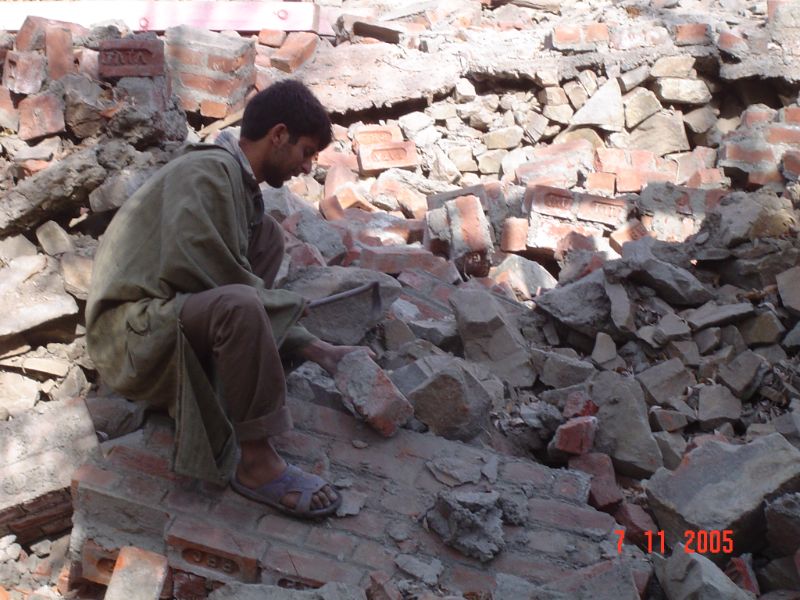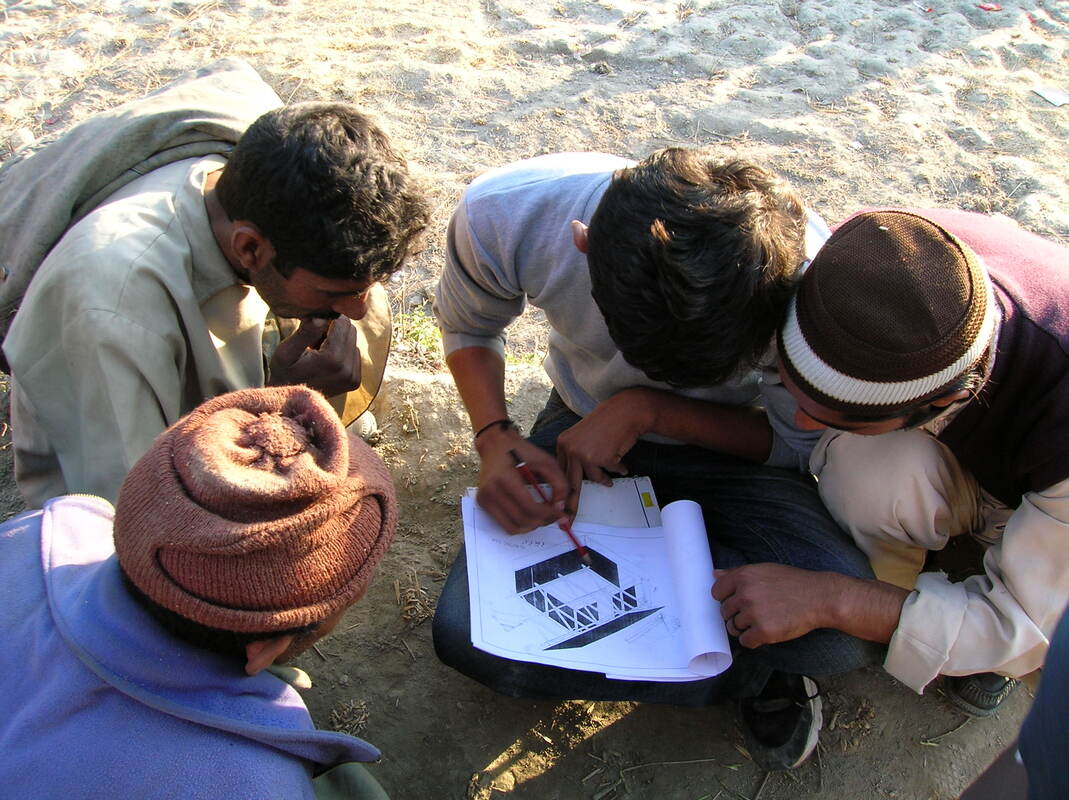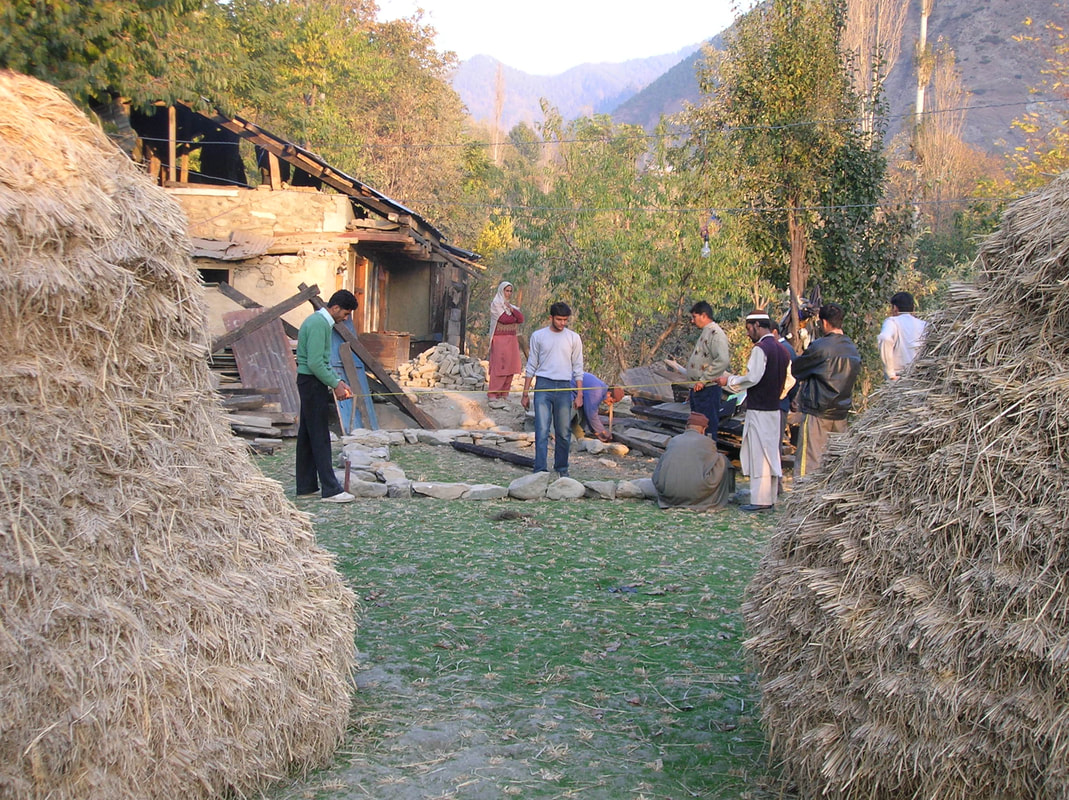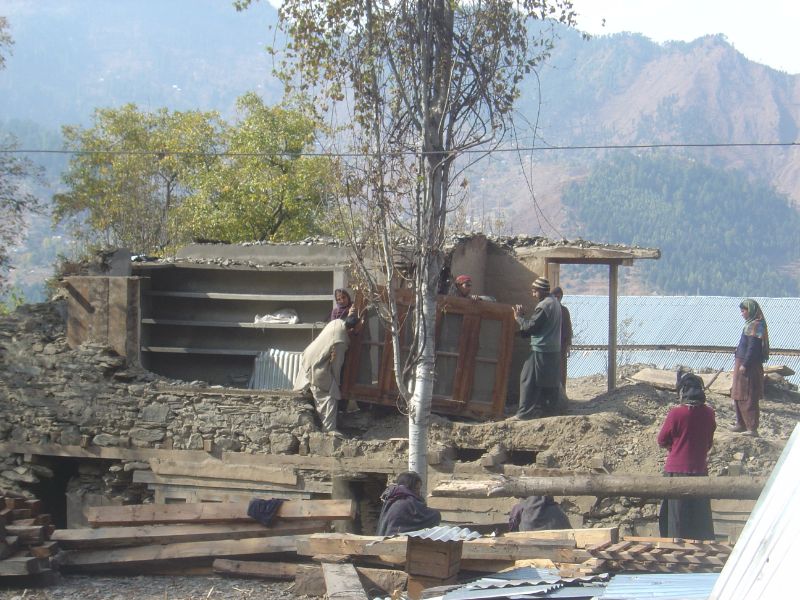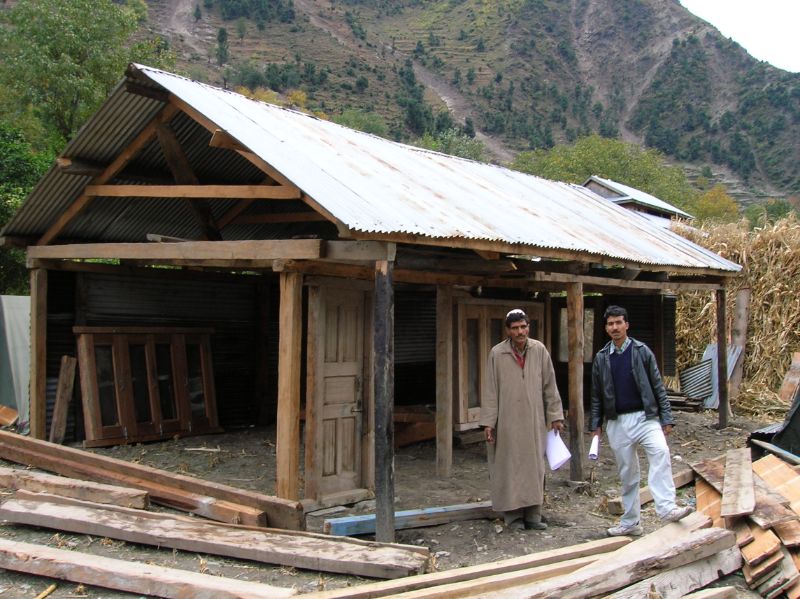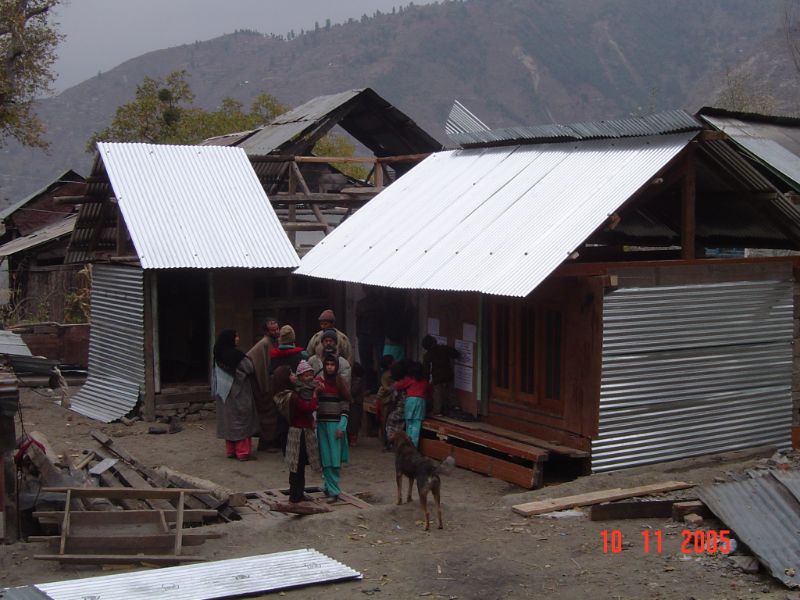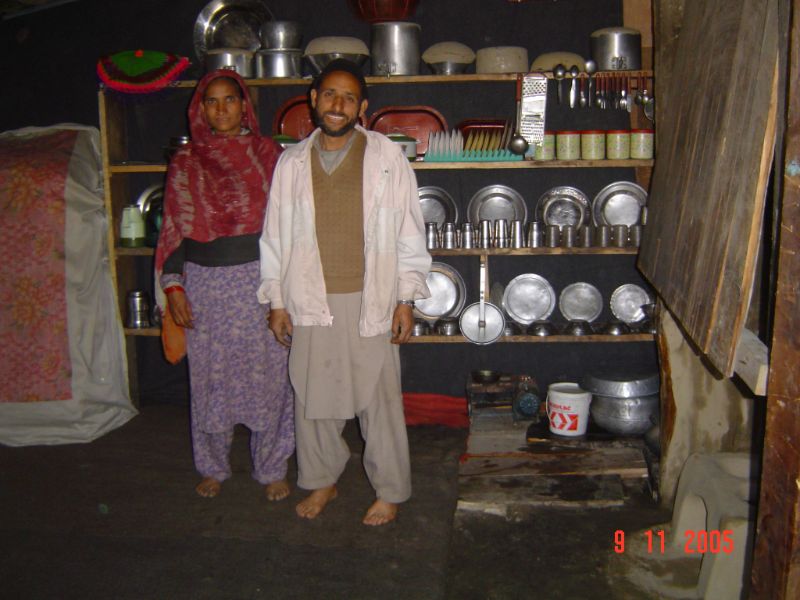OWNER DRIVEN INTERIM SHELTER INITIATIVE IN JAMMU AND KASHMIR
|
Introduction
A massive earthquake measuring 7.6 on Richter scale occurred on 8th October, 2005 with its epicenter in the Muzaffarabad region in Pakistan, triggering shocks of high intensity in parts of Afghanistan and across Northern India, the worst hit being the state of Jammu & Kashmir. According to official reports, 1281 people lost their lives, including 72 army personnel, and 6300 sustained injuries in Srinagar and Jammu divisions. The imminent onset of winter, the difficult access to some of the villages in both regions, the threat of Tangdhar region in particular, becoming inaccessible by road in case of heavy snowfall meant that here was an urgent need for appropriate interim shelters to be completed quickly. |
|
Community Led Reconstruction
Soon after the Earthquake, Government of Jammu & Kashmir invited Hunnarshala for partnering the State in ensuring that the affected had interim shelters before the full onset of winter. Based on the invitation, the rehabilitation activities were undertaken by Hunnarshala. Khowarpara was identified as the first village where Hunnarshala made the demonstration of design, approach, and methodology of community-driven construction. We accompanied 20 families to construct their houses themselves on their own land sites, as per the norms. Within three days, 130 families began constructing their own sheds. Demonstrations with two-three families in all the nodal villages were undertaken to provide confidence and guidance to the community, leading to a ‘shed’ campaign in and around those villages. It primarily created a positive energy and attitude to begin work themselves, and not wait for help from outside. Sabhas were held with the affected in all the 42 villages of the region to communicate the policy, shelter design, understand their problems, clarify doubts, and find solutions with the community. |
|
The Roles of Different Groups and Institutions
|
|
1. banks
The Government compensation for both interim shelter and permanent shelter was disbursed through banks. Banks also facilitated quick transfers of cash to the bank accounts, and facilitating movement of pending deposits was undertaken by the coordination team because lack of liquidity meant a reduced ability to purchase material for the ‘sheds’. Various coordination meetings were held between bank managers and DC whenever necessary. 2. engineers
A team of engineers was developed in forming the design norms, communicating the same in the villages, and in building the capacities and motivation of the Junior Engineers (JE). The JEs were in fact deputed to the different villages and they supported the community in their construction activity. Every JEs was provided with the requisite data base, working files, design requirements, and formats which facilitated their data recording and monitoring. Socio-technical observations by the JEs, their views, and at times even grievances were freely articulated and addressed in the meetings. 3. ngo'S
Non Government Organizations played a very important role without which smooth implementation of the plan would not have been possible. Action aid International: Provided 5544 relief kits including food and non-food items to 31 villages, 109 tents in 8 villages and 635 tins sheets in 8 villages. Confederation of Voluntary Associations-Van Kashmir: COVA-VAN Kashmir set up committees at the village level to coordinate the distribution of relief material. COVA distributed tool kits to 184 families in 26 villages. CINI/Bhoruka Charitable: Distributed firans, 20 tin sheets each and 20ft foam each to 480 families in 6 villages. Inter Vida: Distributed tents, blankets, utensils, food and medicines in 5 villages. Also supplied construction material like plywood and tin sheets to vulnerable families. MSF (Doctors without Borders): Distributed 13770 blankets and 8489 ferrans in 19 villages, 1072 mattresses and 288 stoves in 3 villages, 67 plastic rolls in 18 villages. Oxfam: Provided house kits in 3 villages which included 33 CGI sheets, 16 wooden planks, 14 x 8ft insulation foam, tool kit and 16 sheets of plywood Radha Suomi Satsang, Beas: Set up 11 community centers and schools in Tangdhar region Save the Children: Distributed 876 family kits in 5 villages, 504 food kits in 6 villages, 8622 blankets, 12328 ferrans and 8547 kangris in 24 villages. World vision: Distributed 1393 relief kits in 13 villages, 200 tents in 5 villages (437 families) and 10196 sheets (10 per family) in 12 villages. |
4. THE GOVERNMENT
The clear and strong commitment by the State can be reflected in the Policy to undertake the Interim shelter programme. The J & K Government declared cash assistance of Rs. 30000/- for all those whose houses had fully collapsed, and those who had already received the first instalment of Rs. 40000 as assistance for the permanent reconstruction. In addition to this, the Government also declared an Incentive Package of Rs. 5000/- for all those built their sheds before 30th November, 2005, and whose shelters were certified by the Junior Engineers as having fulfilled the norms. This offer of incentive money turned out to be a motivating factor for the people of this region to construct their sheds quickly as per the norms. 5. MATERIAL BANKS
While people were encouraged to retrieve their material -especially timber from their collapsed houses, material banks were provided by the State for those who would find retrieval difficult or would not have adequate usable material. To make construction material like timber and tin sheets easily available on sale to people, The District Administration had set up material depot systems. The Sale arm of the Government - SICOP, was authorised for supply of CGI sheets, while timber sale was undertaken by the Forest Department by setting up 9 Forest depots in clusters of villages. SICOP was encouraged to undertake mobile ‘sales’ of CGI sheets by taking the sheets to the villages. |
Design and Implementaton
|
The ‘temporary shelter’ had to face all seasonal changes which led to multiple problems both for the affected community and the administration. It was also necessary to recognise that traditional housing structures of most communities across regions are most appropriately positioned to be adapted to becoming an interim shelter for that community.
|
|
With a special request from the J & K Government, the technical team from Hunnarshala Foundation developed the basic structure prototype based on the aforementioned parameters, geological features of the area and family sizes. The ‘interim shelter’ features were in fact developed with the affected community and the local engineers, after understanding the local housing vocabulary, and family needs. However, while encouraging a construction based on traditional housing types and skills, it was also important to introduce a few safety norms given the fact that the region was still seismically active. A few principles that were kept in mind were re-use of construction material which could be salvaged from the damaged houses, providing insulation to the walls, using local technology and practices and fine tuning them to ensure seismic safety. The main material required for building these sheds was wood and tin sheets, which were locally available.
|
|
Further Hunnarshala made an initial demonstration of the approach, methodology and shelter design with 20 families of Khowarpara village. The policy and plan was disseminated via a four page flyer which contained information regarding the compensation package (both in Urdu and English language) and easy to understand drawings regarding the building of these sheds. As a continuation of the plan, a coordination office was set up in the Army premises to ensure the necessary coordination between the various Government functionaries like Government, banks and Executive Engineers. And last but not the least, the fear of cold was one of the major factors that led to speedy construction of interim sheds by the people. The month of November, 2005 was for the community, the Government and the civil society organisations, the only period available to undertake any shelter activity in the region of Tangdhar.
|
Around 90% of the sheds were completed by November, 2006.
|
Timeline
2005 - 2006
Team
|
Sushma Iyenger, Mansi Anand, Harish Hurmade (Kutch Nav Nirman Abhiyan, Kutch)
Sandeep Virmani, Mahavir Acharya, Kiran Vaghela, Hiten Kakadiya (Hunnarshala, Kutch)
Shweta Sharma (Janvikas, Ahmedabad)
Vivek Rawal (Unnati, Ahmedabad)
Dinesh Prajapati (Unnati, Ahmedabad)
Chetan Anand Jha (Foundation for Ecological Security, Anand)
Osman Beg (GRASP, Aurangabad)
Kalyan Dangar (Cohesion Foundation, Ahmedabad)
Mavji Baraiya (Vivekanand Research Training Institute, Kutch)
Madhavan (Chirag, Sitla-Himachal Pradesh)
Nidhi Tiwari, Vasant Sabarwal (Delhi)
Sandeep Virmani, Mahavir Acharya, Kiran Vaghela, Hiten Kakadiya (Hunnarshala, Kutch)
Shweta Sharma (Janvikas, Ahmedabad)
Vivek Rawal (Unnati, Ahmedabad)
Dinesh Prajapati (Unnati, Ahmedabad)
Chetan Anand Jha (Foundation for Ecological Security, Anand)
Osman Beg (GRASP, Aurangabad)
Kalyan Dangar (Cohesion Foundation, Ahmedabad)
Mavji Baraiya (Vivekanand Research Training Institute, Kutch)
Madhavan (Chirag, Sitla-Himachal Pradesh)
Nidhi Tiwari, Vasant Sabarwal (Delhi)
